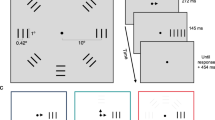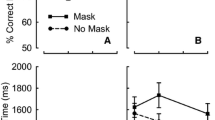Summary
In order to decide between the integration and the interruption theory of backward masking, an experiment is conducted where a cue stimulus preceding the test stimulus by various intervals requires either identification of one test stimulus item (partial report) or recall of the whole test stimulus (full report). In addition, the test stimulus-masking stimulus agynchrony and the luminance of the masking stimulus are varied. When identification accuracy is plotted as a function of cue stimulus-test stimulus interval, the partial-report data can be broken down in two segments: an asymptotic value for “long” (greater than 500 msec) and a region of decreasing accuracy for “short” cue stimulus-test stimulus intervals. The asymptotic value depends on the test stimulus-masking stimulus asynchrony and the luminance of the masking stimulus; however, the decrease of accuracy is not affected by these parameters when the scores are normalized with respect to upper and lower limits of performance. Full-report performance shows a uniform decrease across the whole range of cue stimulus-test stimulus intervals. The manner in which asymptotic values depend on the test stimulus-masking stimulus asynchrony and on masking stimulus luminance is taken as evidence of a two-factor theory of backward masking proposed in a previous paper (Scheerer, 1973). But the data on decrease of accuracy require a revision of this theory: under certain conditions, test stimulus degradation may be compatible with an interruption theory. The different temporal course of partial and full report accuracy is used to distinguish between a peripheral (eye movement-mediated) and a central component in critical item selection.
Zusammenfassung
Zur Entscheidung zwischen der Unterbrechungs- und der Integrationstheorie der visuellen Maskierung wird ein Experiment durchgeführt, in dem ein in verschiedenen Abständen vor dem maskierten Testreiz dargebotener Indikatorreiz entweder zur selektiven Identifikation eines Testreizelements (Teilbericht) oder zur Reproduktion des gesamten Testreizes (Gesamtbericht) auffordert. Außerdem werden das Testreiz-Maskierreizintervall und die Leuchtdichte des Maskierreizes variiert. Wenn die Identifikationsgenauigkeit als Funktion des Indikator-Testreizintervalles aufgetragen wird, zerfallen die Teilberichtskurven in einen asymptotischen Wert für „lange“ (größer als 500 msec) und in einen Bereich abfallender Genauigkeit für „kurze“ Indikator-Testreizintervalle. Der asymptotische Wert hängt vom Testreiz-Maskierreizintervall und von der Leuchtdichte des Maskierreizes ab; im Bereich abfallender Genauigkeit sind die Kurven von diesen Parametern unabhängig, wenn sie hinsichtlich oberer und unterer Grenzwerte der Genauigkeit normalisiert werden. Die Gesamtberichtskurven zeigen einen gleichmäßigen Genauigkeitsabfall über den gesamten Bereich von Indikator-Testreizintervallen. Die Abhängigkeit des asymptotischen Werts vom Testreiz-Maskierreizintervall und von der Maskierreiz-Leuchtdichte wird als Hinweis auf die Gültigkeit der im Literaturbericht (Scheerer, 1973) formulierten Zwei-Faktorentheorie der visuellen Maskierung interpretiert. Jedoch erfordern die Befunde zum Abfall der Identiflkationsleistung eine Revision dieses Konzepts; unter bestimmten Bedingungen kann eine unterbrechende Wirkung des Maskierreizes zu einer Qualitätsminderung des Testreiz-Äquivalents führen. Aus dem unterschiedlichen Verlauf von Teilbericht und Gesamtbericht wird geschlossen, daß die Selektion eines Testreizelements in einen peripheren (durch Fixationsänderung vermittelten) und in einen zentralen Anteil zerlegt werden kann.
Similar content being viewed by others
References
Scheerer, E.: Simultane und sukzessive Informationsverarbeitung bei der Identifikation visueller Reizmuster. Ph. D. Dissertation, Bochum (1970).
Scheerer, E.: Integration, interruption and processing rate in visual backward masking: I. Review. Psychol. Forsch. 36, 71–93 (1973).
Spencer, T. J.: Some effects of different masking stimuli on iconic storage. J. exp. Psychol. 81, 132–140 (1969).
Spencer, T. J., Hawkes, L., Mattson, G.: The effect of a forward indicator on backward masking. J. exp. Psychol. 93, 297–301 (1972).
Sperling, G.: A model for visual memory tasks. Hum. Factors 5, 19–31 (1963).
Author information
Authors and Affiliations
Additional information
Preparation of this report was facilitated by International Postdoctoral Fellowship No. F05-TW-1794 from the Public Health Service, National Institutes of Health, Bethesda, Md., USA, and by Grant NIMH MH-10753 to Dr. Ralph N. Haber.
Rights and permissions
About this article
Cite this article
Scheerer, E., Bongartz, W. Integration, interruption and processing rate in visual backward masking. Psychol. Forsch. 36, 95–115 (1973). https://doi.org/10.1007/BF00424965
Received:
Issue Date:
DOI: https://doi.org/10.1007/BF00424965




